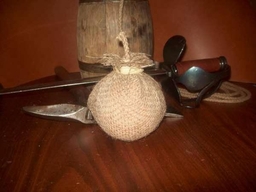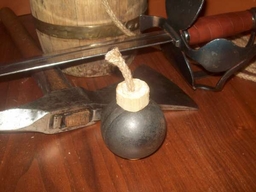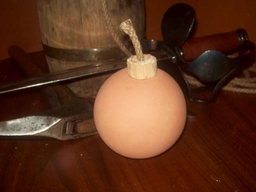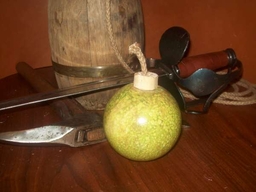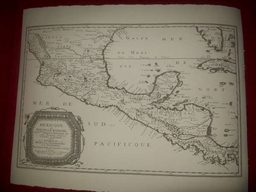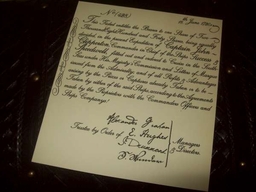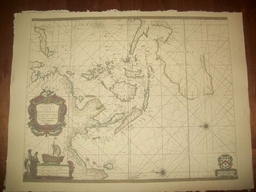-
Posts
703 -
Joined
-
Last visited
Content Type
Profiles
Forums
Events
Gallery
Everything posted by PoD
-
Amazing work mate. I was working on the cuttoe I am making just now and managed to take the skin off me knuckle so thought i better call it a night. I have to attempt the spiral handle carving at some point which I am not looking forward too.
-
I just bought this button and wondered if anyone knew if this button actually is what they say? Also if it is Authenthic would there be any interest in me getting some replicas cast? British c.1705 Queen Anne Royal Livery Button - Lion British found - Complete inc reverse fastening loupe For auction, an original british issue, circa.1705 A.D date, bronze composition, Royal type of Livery button, the button was issued under queen anne of england. The button has finest detail of a typical lion of the period holding crown. specification: Bronze composition 23.0 mm diameter Original & scarce type Futher research I have done suggests that these buttons had Gold Gilting on them too. If I got them replicated would people prefer them in Bronze or in Brass?
-
I was after somewhere that did actual period correct trims but couldnt find any suppliers. I found these sites that do really good trims though: http://www.militarymetalwork.co.uk/categories.php?cat=1 http://www.targettrim.com/index.php?cPath=57 http://www.epicmilitaria.co.uk/section.php/142/1/tresse--braids--ribbons http://vintagesupplyco.com/ribbons.htm
-
Replica of a Grenadoe (this one is steel rather than Iron) such as those used in the 17th-18th century. This one is based on artifacts found on shipwrecks such as the Whydah and the Queen Annes Revenge. It is roughly 2.5" Diameter and is made to fit a Hand Mortar $25 Replica of a Ceramic Grenadoe such as those used in the 17th-18th century. These were filled with explosive compounds and also could contain shrapnel in the form of pistol balls or broken glass. Grenades such as these were also used as 'Stink-Pots' which, Smith explains, 'will burn and fume out a most stinking poyson smoke', and, as Sellers explains, 'being thrown between Decks will be a great annoyance to the Enemy'. They were also used to create confusion immediately prior to boarding, as explained in Falconer's Marine Dictionary of 1771: "The fuses of the stink-pot being lighted, they are immediately thrown upon the deck of the enemy, where they burst and catch fire, producing an intolerable stench and smoke, and filling the deck with tumult and distraction. Admidst the confusion occasioned by this infernal apparatus the (boarding) detachment rush aboard sword in hand, under cover of the smoke, on their antagonist …" These Grenadoes are made from Terracotta and are roughly 3.5" Diameter. They come glazed or unglazed. $25 Replica of a Cloth Covered Ceramic Grenadoe such as those used in the 17th-18th century. Some of the Grenadoes and Firepots recovered from shipwrecks have shown evidence of being covered in a course cloth so this one is covered in a hemp like hessian weave. Roughly 3.5" Diameter $30 As usual Message me if interested. I am always up for a trade too.
-
From the album: My Creations
Replica of a Cloth Covered Ceramic Grenadoe such as those used in the 17th-18th century. Some of the Grenadoes and Firepots recovered from shipwrecks have shown evidence of being covered in a course cloth so this one is covered in a hemp like hessian weave. These Grenadoes were filled with explosive compounds and also could contain shrapnel in the form of pistol balls or broken glass.<br /><br />Grenades such as these were also used as 'Stink-Pots' which, Smith explains, 'will burn and fume out a most stinking poyson smoke', and, as Sellers explains, 'being thrown between Decks will be a great annoyance to the Enemy'. They were also used to create confusion immediately prior to boarding, as explained in Falconer's Marine Dictionary of 1771:<br /><br />The fuses of the stink-pot being lighted, they are immediately thrown upon the deck of the enemy, where they burst and catch fire, producing an intolerable stench and smoke, and filling the deck with tumult and distraction. Admidst the confusion occasioned by this infernal apparatus the (boarding) detachment rush aboard sword in hand, under cover of the smoke, on their antagonist …<br /><br />Roughly 3.5" Diameter<br /><br />$30© © Letters of Marque
-
From the album: My Creations
Replica of a Grenadoe (this one is steel rather than Iron) such as those used in the 17th-18th century. <br /><br />This one is based on artifacts found on shipwrecks such as the Whydah and the Queen Annes Revenge. It is roughly 2.5" Diameter and is made to fit a Hand Mortar<br /><br />$25© © Letters of Marque
-
From the album: My Creations
Replica of a Ceramic Grenadoe such as those used in the 17th-18th century. These were filled with explosive compounds and also could contain shrapnel in the form of pistol balls or broken glass.<br /><br />Grenades such as these were also used as 'Stink-Pots' which, Smith explains, 'will burn and fume out a most stinking poyson smoke', and, as Sellers explains, 'being thrown between Decks will be a great annoyance to the Enemy'. They were also used to create confusion immediately prior to boarding, as explained in Falconer's Marine Dictionary of 1771:<br /><br /> The fuses of the stink-pot being lighted, they are immediately thrown upon the deck of the enemy, where they burst and catch fire, producing an intolerable stench and smoke, and filling the deck with tumult and distraction. Admidst the confusion occasioned by this infernal apparatus the (boarding) detachment rush aboard sword in hand, under cover of the smoke, on their antagonist …<br /><br />Roughly 3.5" Diameter<br /><br />$25© © Letters of Marque
-
From the album: My Creations
Replica of a Ceramic Grenadoe (this example is glazed) such as those used in the 17th-18th century. These were filled with explosive compounds and also could contain shrapnel in the form of pistol balls or broken glass.<br /><br />Grenades such as these were also used as 'Stink-Pots' which, Smith explains, 'will burn and fume out a most stinking poyson smoke', and, as Sellers explains, 'being thrown between Decks will be a great annoyance to the Enemy'. They were also used to create confusion immediately prior to boarding, as explained in Falconer's Marine Dictionary of 1771:<br /><br /> The fuses of the stink-pot being lighted, they are immediately thrown upon the deck of the enemy, where they burst and catch fire, producing an intolerable stench and smoke, and filling the deck with tumult and distraction. Admidst the confusion occasioned by this infernal apparatus the (boarding) detachment rush aboard sword in hand, under cover of the smoke, on their antagonist …<br /><br />Roughly 3.5" Diameter<br /><br />$25© © Letters of Marque
-
Ha ha yep pretty much but more likely a 17th C. portable safe
-
It's the locking mechanism used in one of these: It's hidden beneath the cutout metal plated on this particular one. I actually started to make one of these a couple of days ago (minus the locking bit as I have no idea how that bugger supposed to work) They are the chests carried by the Armada or Treasure Fleets that held the treasures taken from the New World
-
From the album: My Creations
This is a replica of a 1656 French map showing Mexico and New Spain by Nicolas Sanson<br /><br />It is printed on period correct Linen and cotton rag paper.© © Letters of Marque
-
I'll trade for anything. What you got?
-
I have one of these if you are interested in trading: http://www.ravenswoodleather.net/Baldrics/pirate.html
-
This is a replica of an actual share certificate issued for a Privateering voyage in 1720. Its 145x165mm and is printed on period correct paper. This item can be customised with your name (Captain) and the name of your ship(s) $10.00 including shipping (if you want more than one let me know and i can give discount)
-
From the album: My Creations
This is a replica of an actual share certificate issued for a Privateering voyage in 1720.<br /><br />Its 145x165mm and is printed on period correct paper. <br /><br />This item can be customised with your name (Captain) and the name of your ship(s)<br /><br />$10.00© © Letters of Marque
-
They've been pulling up some great artifacts from this era off a wreck they found near the Island of Alderney: http://www.alderneywreck.com/
-
Damn you get all the good festivals over there. Been doing some research into this period all month. Just completed a Queen Elizabeth / Francis Walsingham based letter of marque too.
-
stuck in hospital at the moment so reading pirate port - the story of the sunken city of port royal by robert f marx. very interesting stuff
-
I think these pistols were only actually carried on a horse in a holster attached to the saddle so the belt hooks not really correct but its easier than having to carry it round in your hand all the time.
-
Looks cool. I havent started engraving mine yet as I got an event coming up and dont want it in pieces so close to it. I did however add a Sea Service belt hook to the left side of the gun (being 6'6" it doesnt look to huge cliped onto my belt)
-
It's a great site but if you want to use the pictures as reference its best to save them to your computer as they do take down the pictures when the auctions have finished for a while.
-
ha ha thats funny. The gun laws over here are a bit nuts so its not easy to get a firearms license. A gunsmith decided to see if there was a way around letting reenactors fire period weapons without the need for a firearms license. Basically he took the frizzen cover off the lock and replaced it with a milled out peice of metal that holds a 9mm blank. The hammer has a welded in metal "flint" that strikes the blank. Means that us newbies can at least have something that goes Bang without the trauma of trying to get a firearms license.
-
Looking Good. I've got that exact same gun (although mines converted to fire blanks) and I am considering doing a bit of custom work on mine too.
-
Heres the next 2. Late 17th Century this time: This is a replica of a 1675 English Seachart of the South Sea by John Seller hydrographer to the Kings most excellent majestie. It shows the west coast of North and South America including the gulf of mexico and Panama. Replica 1690 English Seachart of the eastermost part of the East Indies with all the adjacent islands from Cape Comorin to Japan
-
From the album: My Creations
This is a replica of a 1690 English Seachart of the eastermost part of the East Indies with all the adjacent islands from Cape Comorin to Japan by John Seller, Hydrographer to the King <br /><br />It is printed on period correct Linen and cotton rag laid paper.© © Letters of Marque


